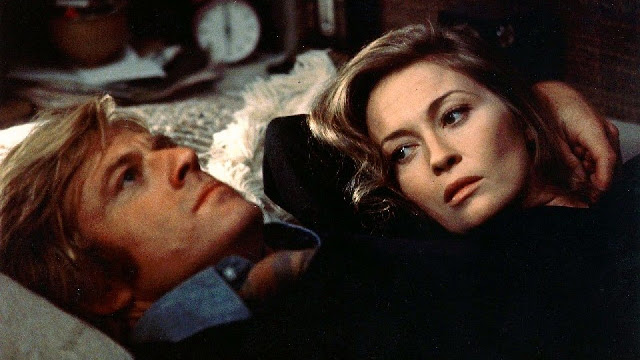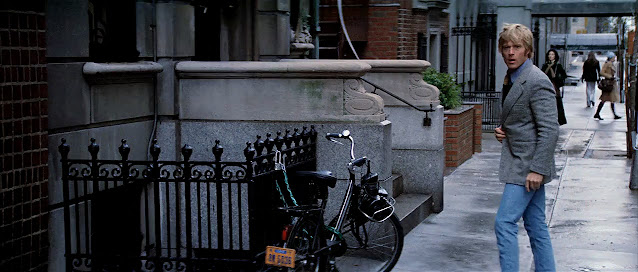 |
| Suzanne Pleshette is a stewardess and lone survivor of a plane crash, Glenn Ford is the meticulous investigator, in 'Fate is the Hunter.' |
While Fate is the
Hunter is no classic, I'm surprised that the airplane drama received poor
reviews and crashed at the box office in ’64. A shame, since Fate is an engrossing flick which spins
the “Grand Hotel in the sky” genre.
 |
| 'Fate' derives its drama from the aftermath of a plane crash, unlike most airplane epics. |
Instead of drama caused during a perilous flight, Fate is the Hunter tells, in Citizen Kane-style flashback, from its characters,
their recollections of a flight captain whose plane has crashed. The investigator
hero tries to get at the truth and restore the reputation of his war buddy,
which may not be the same thing, according to his naysayers.
 |
| Glenn Ford's Sam McBane retraces the last day of pilot Jack Savage's life, right through to the plane crash, with traumatized stewardess Suzanne Pleshette. |
Fate is the Hunter is definitely escapist
entertainment: the story is clever, cast is solid, and cinematography and score
are beautiful. Yes, it follows the tropes of the genre. Yes, the movie
appears to be filmed on a B+ budget. And yes, the characters are archetypes or
stereotypes, depending on your love of old movies. But it is briskly told, with
several strong performances, and Fate
works just fine within its conventions. At an hour and forty five minutes, Fate’s flight time is much more
efficient than Airport or The High and the Mighty, two smash hits
of the genre.
 |
| Despite the lack of big special effects, the build-up to the crash and the aftermath are intense. |
Glenn Ford has never been one of my favorite actors,
especially as he grew older. He seemed solid at best, stolid at worst. Yet,
Ford has done some good work, and he's especially effective here. As Sam
McBane, the man investigating the crash, he is a perfectionist and a believer
in facts. Yet he's emotionally conflicted, as he is both investigating and
defending the character of his best friend. Sam gradually finds out that he
knows more about science than he does his best friend. Ford has several emotional
scenes that seem very uncharacteristic for his acting style. Yet, he plays
them earnestly and effectively. And unlike other actors of the era, he's not
macho, but empathetic.
 |
| Glenn Ford is an empathetic hero who is trying to resolve what went wrong with the plane that best pal Rod Taylor was flying that fateful night. |
Rod Taylor, on the other hand, is an actor I always liked
and think was underrated in his heyday. However, as the playboy pilot Jack
Savage, he's over the top at times, in playing this big personality. At times, you
wonder why anyone could find someone so insufferable so irresistible. Even when
you find out "the rest of the story," as Paul Harvey would say, Rod
as Jack is still too much. But Taylor does have his more subtle scenes,
especially with Nancy Kwan. Everyone else in this movie comes and goes,
as they are parts of this charismatic character's life. Nancy Kwan is his last
love, and gives Sam some food for thought on how to view the case. Kwan plays a
scientist and it's great that she gets to do so in a non-sexist way. She is no
"lady scientist." Her Sally Fraser may be stunningly lovely, but she
is a strong, wise person. And Kwan plays her simply and strikingly.
 |
| Rod Taylor is the late pilot whose rep is on the line. Here is the captain in a flashback, with Nancy Kwan, as the scientist who sees the real Jack Savage. |
Constance Towers plays Sam's loyal assistant and love
interest, Peg Burke. Powers, who made a big splash in Sam Fuller's pulp films
about this time, has such a bland role here, though her presence and
intelligence are evident.
An unbilled Dorothy Malone plays Jack's ex-fiancee, a rich
heiress who seems like a tamer version of Malone's mambo loving party girl in Written on the Wind. She sure knows how
to milk her few moments on screen, with those wide eyes and energetic eyebrows
working overtime!
 |
| Dorothy Malone makes an unbilled cameo appearance with Marilyn Monroe's "Happy Birthday, Mr. President" hairdo! |
And Suzanne Pleshette is Martha Webster, the stewardess on
the ill-fated plane. Pleshette is essentially in the beginning and end of the
movie, but her striking looks, great humor, and no-nonsense acting are always
refreshing. Suzanne had that quality which Ann Sheridan also possessed. Most of
Pleshette’s scenes are with Taylor and Ford, and she holds her own against the
leading men.
 |
| Suzanne Pleshette as no-nonsense stew Martha Webster, looking lovely here. |
While it's not an all-star cast, Ford was number #1 at the box office in ‘58, and Malone was still
coasting on her '57 Oscar win. The younger cast—with Taylor, Pleshette, Kwan,
and Towers—were considered strong up and comers. And the supporting cast
had a bevy of familiar faces. Wally Cox is a standout with his memory of the
real Jack, along with Mary Wickes as the pilot’s nosy landlady, and a strong
performance by Mark Stevens as Jack’s drinking buddy. As a favor to the
producer, Jane Russell appears in a WWII USO show flashback as herself. Frankly,
I’ve never cared for Russell’s rudimentary singing and dancing, but Jane’s good
humor still comes across. Maybe Fate
just seemed like another old fashioned movie at the time? Hard to say!
 |
| Jane Russell as herself, performing 'for the boys,' like she did 20 years earlier in real life. |
PS about the cast: Why was Rod Taylor made up to look older
in the current scenes, while his war buddy, Glenn Ford looks the same in both
present day and flashback? Ford was 16 years older than Taylor, and quite honestly,
looked it. Were they trying to even things out in the present day scenes?
Ralph Nelson, who specialized in smaller, realistic movies
like Lilies of the Field, directed.
It’s notable that the way women and two black characters are treated was
forward-thinking. The prolific Jerry Goldsmith created one of his first film
scores here, and it’s lovely. Milton Krasner got the film’s sole Oscar
nomination for his almost noir-like cinematography.
 |
| Secret's in the sauce! That's a subtle hint, as Glenn's investigator recreates the fateful flight. |
This is one of those movies that plays well within its genre
and is fun to curl up with, when you're in the mood for something entertaining,
with familiar faces you’re fond of.
Here’s more on Suzanne Pleshette!
My tribute to Suzanne, a childhood favorite: https://ricksrealreel.blogspot.com/2016/07/suzanne-pleshette-next-liz-taylor-who.html
My review of Youngblood
Hawke: https://ricksrealreel.blogspot.com/2019/07/writing-women-dont-mix-for-youngblood.html
FYI: I
put all the movie overflow on my public FB movie page. Check it out
& join! https://www.facebook.com/groups/178488909366865/
 |
| Here's a sweet set shot of Rod Taylor, Jane Russell, and Glenn Ford! |


































